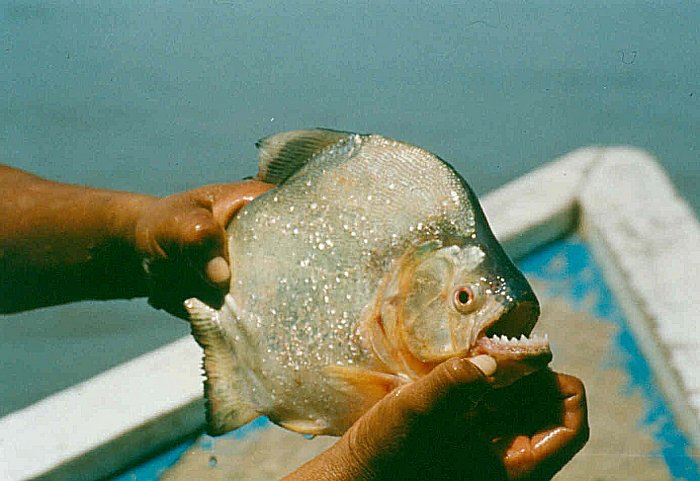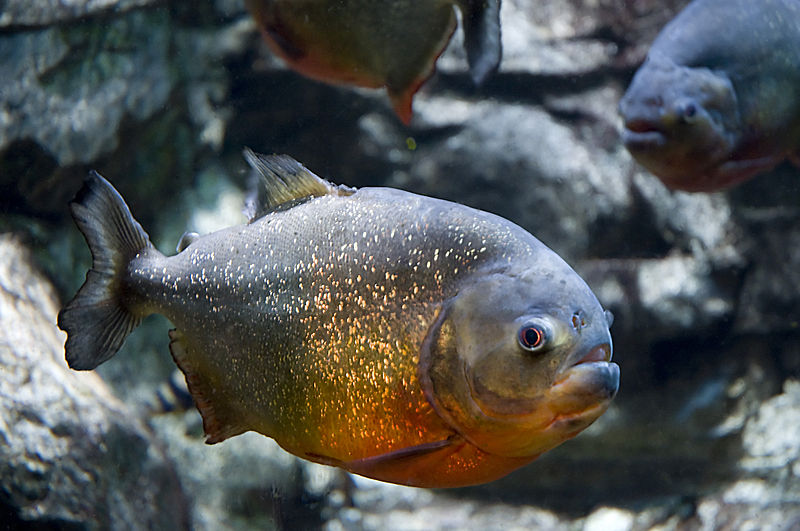Hello, Craig here. In my last blog, I introduced the infamous Red-bellied Piranha. Now let’s talk a less common species, the Black Piranha.
 Serrasalmus rhombeus is a brute of a fish. Like all piranha species, the Black Piranha calls the Amazon and Orinoco river basins of South America their home. Though this is a relatively widespread fish, there is actually a “complex” of species that all fall under the “rhombeus” name. All of them develop blood red eyes as they mature and their colors range from silver to black to a pale grey. The Black Piranha is a sleek top end predator that can attain sizes or well over 12 inches. Some people make claims that this beast can grow as large as 20 inches or more.
Serrasalmus rhombeus is a brute of a fish. Like all piranha species, the Black Piranha calls the Amazon and Orinoco river basins of South America their home. Though this is a relatively widespread fish, there is actually a “complex” of species that all fall under the “rhombeus” name. All of them develop blood red eyes as they mature and their colors range from silver to black to a pale grey. The Black Piranha is a sleek top end predator that can attain sizes or well over 12 inches. Some people make claims that this beast can grow as large as 20 inches or more.
As juveniles, the Black Piranha is known to feed on the fins and scales of larger fish, as well as insects and small crustaceans. This behavior changes as the fish ages. At maturity, the rhombeus piranha is a lightning-fast predator. Their bodies are laterally compressed and very streamlined. This allows for quick pursuit of their prey. Whether taking a whole fish, or simply shearing off parts of their prey, the attack is always fast and brief.
Most of the fish in this complex are found in fast flowing rivers, but the larger adults can be found in deeper waters. In the home aquarium, keeping a single specimen in a large tank of at least 120 is the only way to go. These fish are highly aggressive towards one another in captivity, and will rarely accept others as tank mates. Typically a shy fish, it is wise to provide a large piece of driftwood for cover. Keeping the lighting subdued will encourage the fish to feed and be more active at all hours of the day. Powerheads can be used to create current and oxygenation as found in their native habitat, and will help to keep this species of piranha in excellent health. Feeding will require a varied diet of shrimp, fresh fish filets, and pellets. Some individuals are quite stubborn, and may prefer live foods when first acquired. If you are going to feed them live fish, it is always a good idea to quarantine the fish before you offer them as food to your piranha. It is also recommended that you do not feed your piranha live goldfish, but instead opt for guppies, rosey-reds or mollies. A large and efficient bio-filter will be needed to help to deal with the waste the fish produces. Weekly water changes will help to keep the environment in top condition and allow for the best possible growth rate and coloration.
While these fish are not readily seen for sale in stores, you do see them available from time to time. They are hardy and long-lived aquarium inhabitants when they are cared for properly. Next time I will talk about one of the most unique of all piranha – Serrasalmus elongatus , the Elongate Piranha.
Black Piranha image referenced from wikipedia and originally posted by Torox
 That Fish Blog – Aquarium Advice and Information
That Fish Blog – Aquarium Advice and Information

